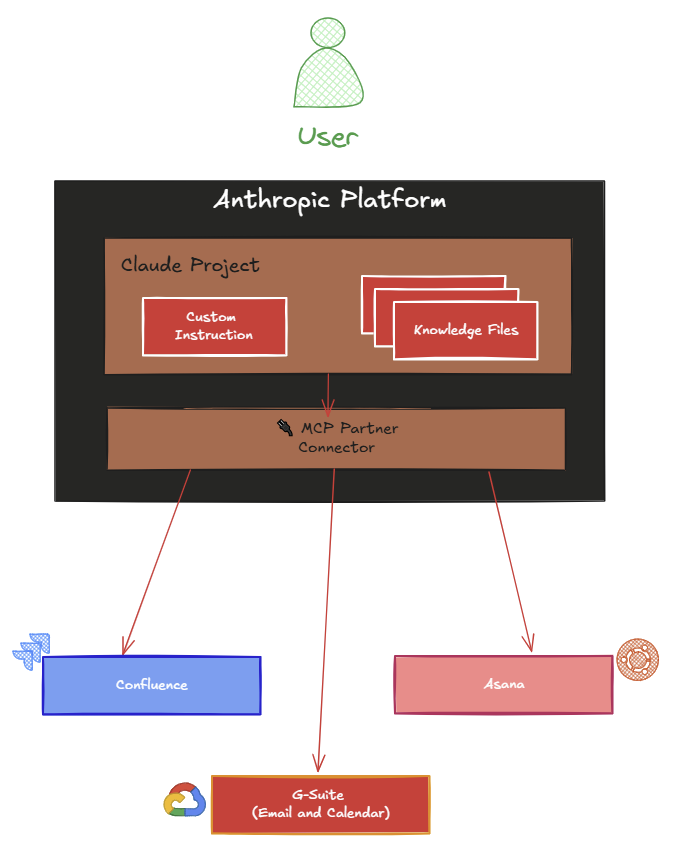I'm Building an AI Project Manager That Handles 80% of My Admin - Part 1
And it doesn't involve a single line of code
Every knowledge worker has a secret second job.
It’s not the role on your LinkedIn profile. It’s the invisible admin that eats your calendar.
Updating tasks in Asana or Jira.
Chasing teammates for status updates.
Writing daily briefs for Confluence.
Forwarding emails to the right people.
Rolling over half-finished sprint work.
I know because I live it. I was spending 12 hours a week just pushing digital paper. That’s an entire day and a half each week where I wasn’t doing programming or strategy, wasn’t problem-solving, wasn’t thinking creatively.
If you’re in project management, this is your entire week. If you’re in leadership, it’s the overhead that steals your focus. Every team has people quietly drowning in the same tide of repetitive work. Meetings end, and everyone scatters — not to do the real work, but to update dashboards and chase down details. It’s the hidden tax of modern knowledge work.
A few weeks ago I wrote about how I’d built a Professional Intelligence System for a friend of mine who runs a recruitment business. I took the learning from that and decided to see how much of my own workflow I could outsource to the machine.
Turns out, the answer is - quite a lot! Let’s get into it.
The Aha Moment from a Month Ago
What I wrote about at the beginning of August has stuck with me a lot more than I though it would.
“The industry keeps trying to build better containers for AI (LLMs, agents, platforms, integrations), when what people actually need is better intelligence within the containers they already have.”
In building this new Project Management system, this describes the breakthrough. I didn’t ditch Asana. I didn’t migrate from Confluence. I didn’t need to install yet another dashboard app.
The breakthrough is to think about this as giving your existing tools a brain.
Anthropic’s Claude Projects let you wire the model directly into your workflows through something called MCP connectors. With the right instructions, Claude doesn’t just chat—it works with the connected systems.
With some files, a customer instruction (in other words a prompt), I’ve designed an AI Project Manager that handles the boring 80% of admin, leaving me with the high-leverage 20%.
The High-Level Architecture
Here’s how it works. At the core is a Claude Project.
This is the brain. We communicate with Claude through natural language. It has a custom instruction (a meta-prompt) that tells it: “You are my Project Ops Brain. Your job is to keep tasks updated, brief stakeholders, and surface risks.”.
The Claude Project also holds knowledge—things like project goals, team information and deadlines. This ensures that the project manager has enough context - in other words, it’s like giving the AI an operating procedure to observe.
Then we have the arms and legs - the MCP Connections to the downstream systems we’re all using.
Asana → tasks and boards
G-suite → inbox and calendar
Confluence → team documents
With these connected to the Claude Project, I no longer need to access these systems myself. I can type or talk to Claude form within the Project and access the information I need.
This is the great time saver - Four systems accessible from one natural language user interface.
The Workflow in Action
Let’s walk through a morning routine.
1. Inbox Sweep
Before: I’d open Gmail, scroll through loads of threads, filter out noise, and manually cross-check tasks. Half the time, I’d lose the thread of a conversation.
After: I ask Claude to check my Gmail:
“Tim said he’s email me when he’s finished with the data assessment task for customer X - has he done that?”
Claude finds the emails and cross-checks Asana: the task is indeed complete.
Claude closes it, updates the board, and thanks Tim for being diligent!
What used to be three tools is literally seconds.
2. Asana Hygiene
Before: Every Friday, I’d spend half an hour dragging tasks across columns, updating statuses, splitting subtasks, and writing notes for the team.
After: I ask Claude to scan the sprint board and run a hygiene task - remember those files added to the Claude Project knowledge? This is how Claude knows for sure what I want when I ask for “Asana hygiene“. From here, it:
Moves overdue items into the next sprint
Flags blockers in red
Suggests which tasks should be split into subtasks
It’s like having a Scrum Master who never sleeps.
3. Daily Confluence Update
Before: I’d write daily or weekly briefs: copying notes, formatting text, finding the right Confluence page and pasting updates.
After: By 9 a.m., following a simple command, Claude compiles yesterday’s activity into a formatted daily brief:
What moved forward
What’s at risk
What’s blocked
Then it posts directly to Confluence. I don’t need to write status updates anymore. I just read them.
4. Meeting Support
Before: Every meeting generated 30 minutes of follow-up admin. Translating half-legible notes into structured tasks, assigning owners, updating Jira/Asana boards.
After: After a stand-up, I paste rough notes (or a meeting transcription, if one has been generated) into Claude:
“Tim is tackling login bug.”
“Owen is waiting on design assets.”
Claude translates this into updated Asana tasks—assigned, tagged, and scheduled. Again, the knowledge in the project - the system knows who Tim and Owen are, and what they should be working on.
The admin that normally trails every meeting? Gone.
Why Now?
This wasn’t possible two years ago.
Yes, you could write scripts, wire up Zapier automations, or build a custom bot. But every one of those required coding skills, config skills, brittle integrations, and ongoing maintenance.
What’s changed is that AI models can now run the logic layer.
They can parse vague instructions: “Check if Tim finished his task and update the board if he did.”
They can decide what action to take.
They can connect into your tools using MCP.
That’s the inflection point. You don’t need a developer. You just need a project, a prompt, and a connector.
Then there’s the speed - it’s incredibly quick to stand these types of solutions up.
What This Isn’t
It’s important to be clear, this isn’t about replacing project managers. It’s about giving you some leverage if you’re consumed with these tasks as a hidden role.
This isn’t a chatbot. It’s not here to chat about tasks—it’s here to do them.
This isn’t perfect AI magic. You still need to guide it, sanity-check it, and feed it good instructions.
But once it’s in place, it quietly saves you hours every week.
The Bigger Picture
What I’ve shown you here is just one system. But it’s the start of something bigger. We’re moving from “prompt engineering” to workplace intelligence engineering. As I’ve said before, we don’t need more tools, we need to be using what’s already here much better.
This is also very profound for folks who feel as through they need to use platforms like n8n to automate their workflows, but feel intimidated by the development surface. Taking the approach of working with a Claude Project and connecting to the core systems you use, this is a much easier option in my opinion.
As a result, I think this is where AI could live for the next 12-18 months:
Automating the 80% of admin work everyone hates
Sitting inside your existing tools (no rip-and-replace)
Requiring no code, just structured instructions
Think about it:
A Sales Intelligence System that drafts proposals from HubSpot data.
A Finance Intelligence System that reconciles Stripe + Drive + Notion.
A Marketing Intelligence System that creates content calendars in Asana and assets in Canva.
Different roles, same pattern: a Claude Project at the centre, MCP connectors as the arms and legs.
What’s Next?
Most of us didn’t sign up to be human project trackers. With tools like this, now you don’t have to be. This AI project manager that handles 80% of my admin.
Next week, I’ll show you exactly how it works.
Until then,
Chris
Got any ideas for a Professional Intelligence System to boost your workflows? Share your ideas in the comments.





Looking forward to the demo/explanation of the Professional Intelligence System !
This is awesome! I’ve been working on something similar, but focused on the enterprise side, building an MCP that connects directly to large-scale databases.
The idea is simple: instead of engineers constantly writing queries and pulling answers, AI handles the SQL, talks to the database, synthesizes the data, and presents it to users. Millions of rows can be turned into insights, so thorough lookups and decisions happen in minutes instead of days.